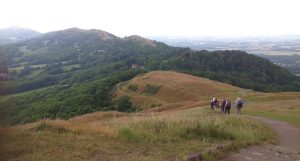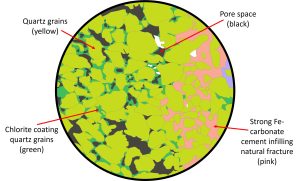The latest Triassic to earliest Jurassic interval is one of the ‘Big-Five’ extinction events of the Phanerozoic. This event provided a platform for the diversification and evolution of many groups of organisms through the Mesozoic (Boomer et al., 2021). The most recent issue of the Proceedings of the Geologists’ Association (PGA) (volume 136, part 2) comprises a thematic set of papers focused on this interval in Northern Ireland. Merlin’s resident stratigrapher, Dr Phil Copestake, co-authored four of the papers through his research collaborations with Dr Ian Boomer (Geosciences Research Group, University of Birmingham).
The latest Triassic to earliest Jurassic is generally well represented at outcrop and sub-crop across much of the British Isles both offshore and onshore, including the famous Jurassic Coast World Heritage site in Devon – Dorset. However, it has been relatively little studied in Northern Ireland despite the existence of a number of outcrop and borehole records. Outcrops are most commonly found on the coastal margins of the Paleogene basalt plateau of the Antrim Lava Group in Northern Ireland.
The first of the four papers co-authored by Dr Phil Copestake (Raine et al., 2021a) reviews the development of the more limited Triassic to Lower Jurassic sediments in Northern Ireland and those of the Republic of Ireland which are more extensive and thickly developed (see Merlin, 2020 for more detailed documentation of the Republic of Ireland offshore stratigraphy).
In Northern Ireland, the Jurassic is relatively thin at outcrop, however wells and boreholes demonstrate significant thicknesses of Lower Jurassic along the North Antrim coast (Boomer et al., 2021). The Boomer et al., 2021 paper contains an important documentation of the Lower Jurassic stratigraphy of the Ballinlea-1 hydrocarbon exploration well. This well was drilled by Rathlin Energy and its partner Mancal Energy in the Rathlin Basin in 2008 targeting a Palaeozoic structure. The stratigraphic succession in the well, which penetrated the thickest section of Early Jurassic strata (566m) yet known from onshore Ireland, was interpreted to span the Hettangian to Early Pliensbachian interval, on the basis of microfossil based biostratigraphy (foraminifera, ostracods).
The latest Triassic to earliest Jurassic transition has been widely studied due the occurrence of a major world wide extinction associated with a global hyperthermal event in this interval. The stable-isotope record also shows a number of distinct geochemical events in the global carbon cycle that can be recognised in the stable-isotope record across this boundary interval at many localities. Two fully-cored boreholes from East Antrim in Northern Ireland (Carnduff-1 and Carnduff-2) have penetrated sediments of latest Triassic to Early Jurassic age (Rhaetian to Early Sinemurian) spanning this boundary interval. Ammonites, foraminifera, ostracods and palynomorphs provide a robust chronology as well as insights into palaeoenvironmental conditions during this period. Stable-isotope analysis of both carbonate and organic carbon show a distinct carbon isotope excursion (CIE) in both fractions through the Cotham and Langport members (Lilstock Formation, Penarth Group, latest Triassic) which are considered to correlate with the distinctive ‘Initial’ CIE witnessed in South West England and probably in the Global Stratotype Section and Point (GSSP) in Austria and other sites across the world (Boomer et al., 2021b). In these sections the Initial CIE occurs a short distance below the Triassic/Jurassic boundary defined in the GSSP section by the incoming of ammonite Psiloceras spelae. In Britain, this ammonite marker is absent, rendering it necessary to define the base of the Jurassic on the basis of proxy criteria, such as the Initial CIE or palynology and microfossil bioevents, all of which are well documented in this paper.
The Lough Foyle Basin is a half-graben that straddles the border between Northern Ireland and the Republic of Ireland containing sediments of Early Carboniferous to Holocene age. The basin’s post-rift succession is represented by sediments of the late Triassic Penarth Group and Early Jurassic Lias Group. The lithostratigraphy and biostratigraphy of that interval are revised in the paper by Raine et al. (2021b) using new borehole material and existing outcrop. The Lias Group (Waterloo Mudstone Formation) in this basin differs from that developed elsewhere in Northern Ireland in that five distinct members can be recognised, four of which are newly described. One member includes the deltaic and shelfal sandstones of the Hettangian to Early Sinemurian aged Tircreven Sandstone Member. This is the only sandstone unit known in the Jurassic succession of Northern Ireland. It provides evidence of the proximity of the nearby Irish Landmass and partly correlates age wise with the Early Sinemurian Loughbaun Sandstone Member in the North Celtic Sea Basin (Merlin, 2020).
This set of papers represents a collaborative effort of many authors, managed and scientifically led by Dr Ian Boomer (Geosciences Research Group, University of Birmingham), Dr Rob Raine (Geological Survey of Northern Ireland) and Dr Mike Simms (National Museums Northern Ireland). The journal issue was dedicated to the life and work of renowned Triassic and Lower Jurassic researcher Prof. Tony Hallam, formerly of the University of Birmingham, who passed away just as the publishing project was conceived. All of the papers had been previously published online prior to the release of this special issue.
Other papers in the thematic set include the documentation of the first records of dinosaur remains from Ireland (Simms et al., 2021).
Publication References:
Boomer, I., Azmi, A., Copestake, P., Raine, R. 2021a. Lower Jurassic (Hettangian–Pliensbachian) microfossil biostratigraphy of the Ballinlea-1 well, Rathlin Basin, Northern Ireland, United Kingdom. Proceedings of the Geologists’ Association, 132, 657 – 667. First published online in 2020.
Boomer, I., Copestake, P., Raine, R., Azmi, A., Fenton, J., Page, K., O’Callaghan, M. 2021b. Stratigraphy, palaeoenvironments and geochemistry across the Triassic–Jurassic boundary transition at Carnduff, County Antrim, Northern Ireland. Proceedings of the Geologists’ Association, 132 (2021), 667 – 687. First published online in 2020.
Raine, R., Copestake, P., Simms, M.J., Boomer, I. 2021a. Uppermost Triassic to Lower Jurassic sediments of the Island of Ireland and its surrounding basins. Proceedings of the Geologists’ Association, 132 (2021) 627–640. First published online in 2020.
Raine, R., Fenton, J., Azmi, A., Boomer, I., Copestake, P. 2021b. Uppermost Triassic to Lower Jurassic stratigraphy in the Lough Foyle Basin of Co. Londonderry, Northern Ireland. Proceedings of the Geologists’ Association,132, (2021), 641 – 656.
Simms, M. J., Smyth, R. S. H., Martill, D. H., Collins, P. C. & Byrne, R. 2021. First dinosaur remains from Ireland. Proceedings of the Geologists’ Association, 132, (2021), 771-779.



